Last October when I hit my 65th birthday, I decided it was time to re-prioritize the old bucket list. Looking back on the Medicare milestone, I realize now that many of the limitations I began feeling at the time were due to the constant barrage of AARP emails and well meaning newsletters preparing me for impending decrepitude. Around this time, I began to manifest aches and pains and imaginative scenarios that led me to think my physicality as I knew it was about to be over. So I had best “git to gittin’” as they say in the south.
I decided rather than my usual prioritization based on desire or geographical proximity, I would instead prioritize according to difficulty. Not just physical difficulty, but those destinations requiring a certain level of travel-savvy as well. I decided to tackle some of the trips on my list that would not only tax me physically, but also test my travel mettle in destinations with little to no travel infrastructure. So last October, I put down a deposit on two escorted tours; the Dragoman overland trek through Sudan to Ethiopia in January, and a two week tour through Pakistan in April (now cancelled, obviously.) That left me two months to fill, with India being the obvious choice in between.
When I wrote about my time in India back in 2002, I titled the chapter “A Fine Line Between Love and Hate.” India is nothing if not intense. I described it back then as an “assault on the senses.” During my year-long trip on the heels of 9/11, I managed to survive a month there. But could I double that love-hate relationship to two months, now being eighteen years later and leading into my “golden years?”

Fort Kochi is full of small homestays with amusing names like the “Delight,” “Dewdrop” or “Raindrop.” But the one that made me chuckle was the “Homely Homestay.” To the Indians and British, the word “Homely” means cozy and comfortable like the home. But to us Americans, it means “unattractive,” not exactly a name you would want to market.
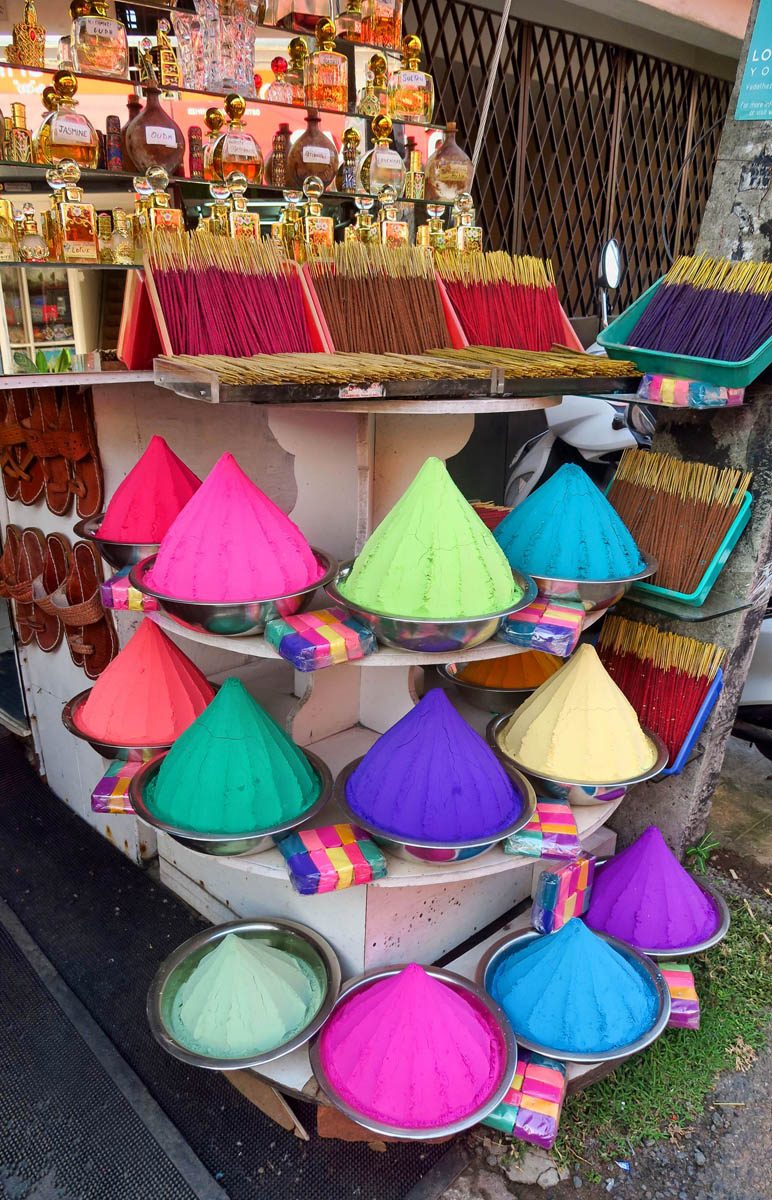
Incense and gulal, or coloured powders used for the typical Hindu rituals, in particular for the Holi festival, as well as weddings and funerals.
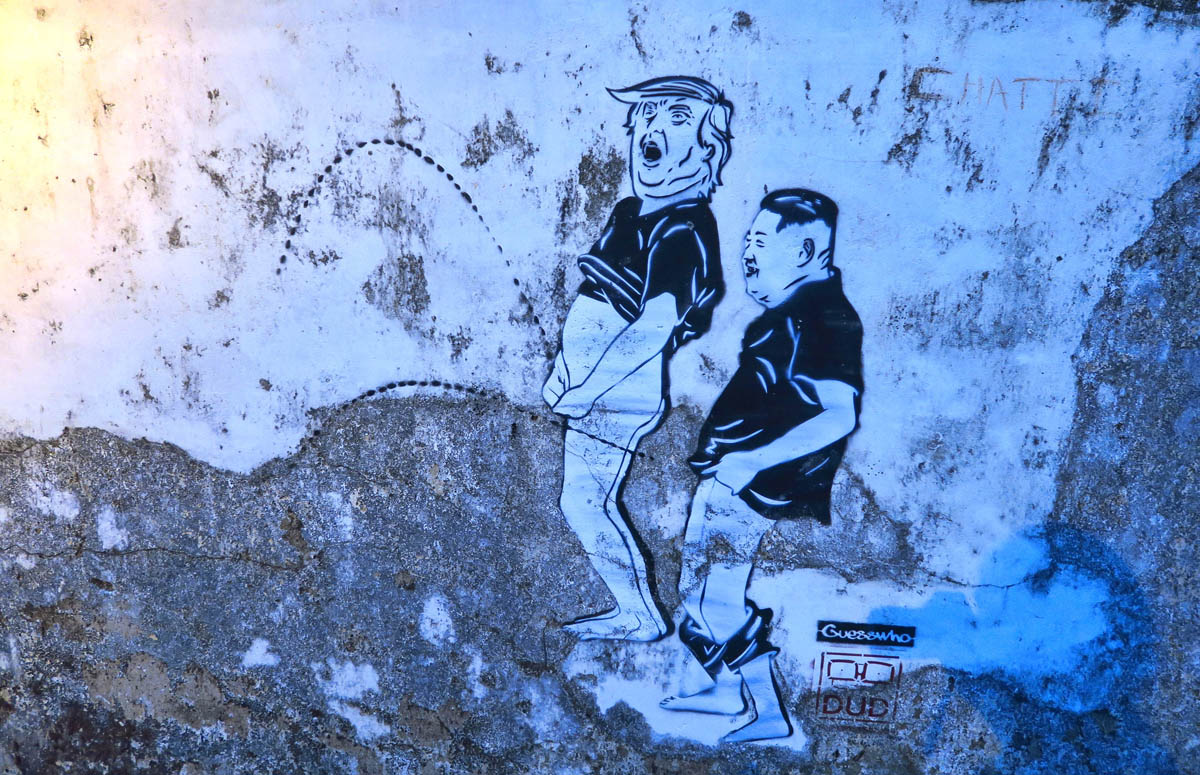
While I agree the concept is accurate, the body sizes might be a bit off.

Thali, an Indian meal wth curries, dal (lentils) raita (yogurt with vegetables) and roti. In the center is paratha, a flaky layered Indian fried bread.

This woman is selling roti, or chapati bread made of whole-grain wheat flour without leavening.

These young girls were shouting at me from across the street, motioning for me to take their photo. Their enthusiasm made the photo blog-worthy.

There are no laundromats in Fort Kochi. Everyone uses the services provided by the “Dhobi Khana,” (community laundry space.) The Dutch government brought the ancestors of this Tamil-speaking Vannan community to Cochin in 1720 for washing the Dutch army’s uniforms, originally done in sand bored ponds. In 1976, this more “modern facility” was built.
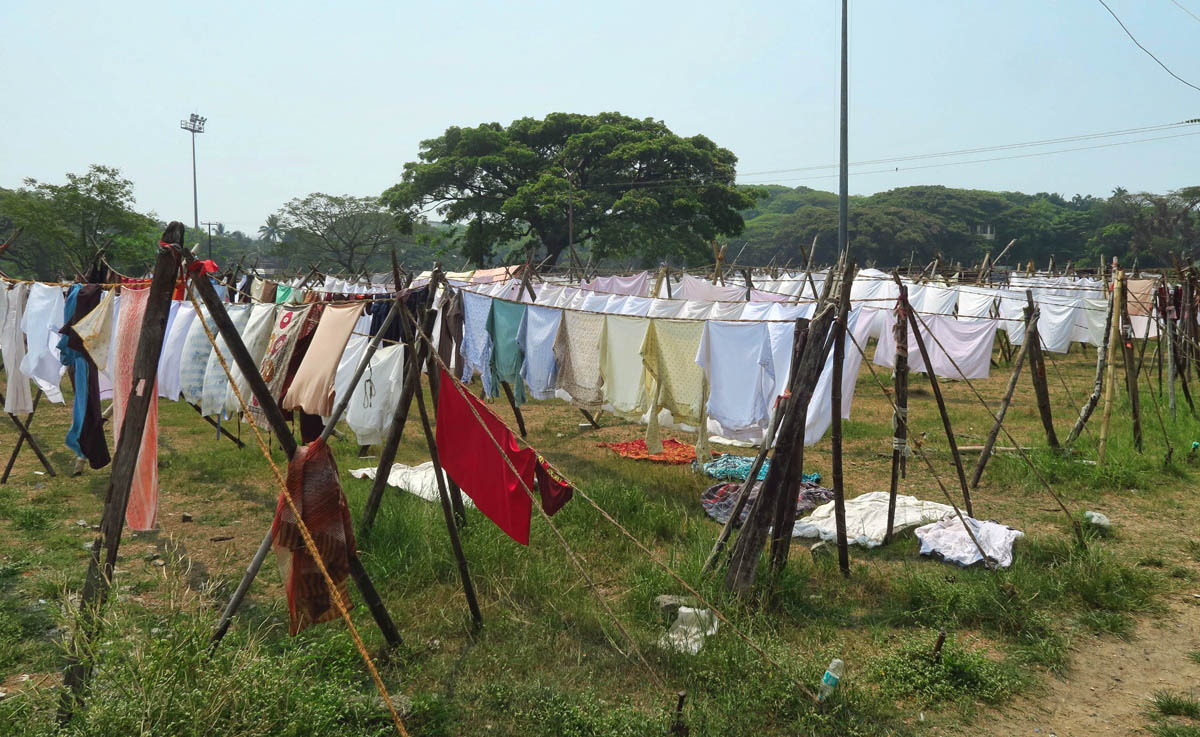
Clothes are washed in the traditional method, beating them on stone, and using rice water for starch. Note no clothespins are used. Corners are tucked into twisted rope. The families offer laundry service to houses, hotels, homestays, hospitals, and government offices.

Many workers still use charcoal irons. This man encouraged me to pick his up. I could hardly lift it with both hands!

This entire area was once a principle port on the Spice Routes. Spices are still a key export. (Note the orange bundles at the end are blossoms containing nutmeg.)

The old “Ginger Palace” is still in operation today.

This white foreground might look like gravel, but it is fresh ginger coated in lime drying in the sun.

Fresh ginger is a key ingredient in “masala” the spice used in everything from Chai to Chicken Tikka.
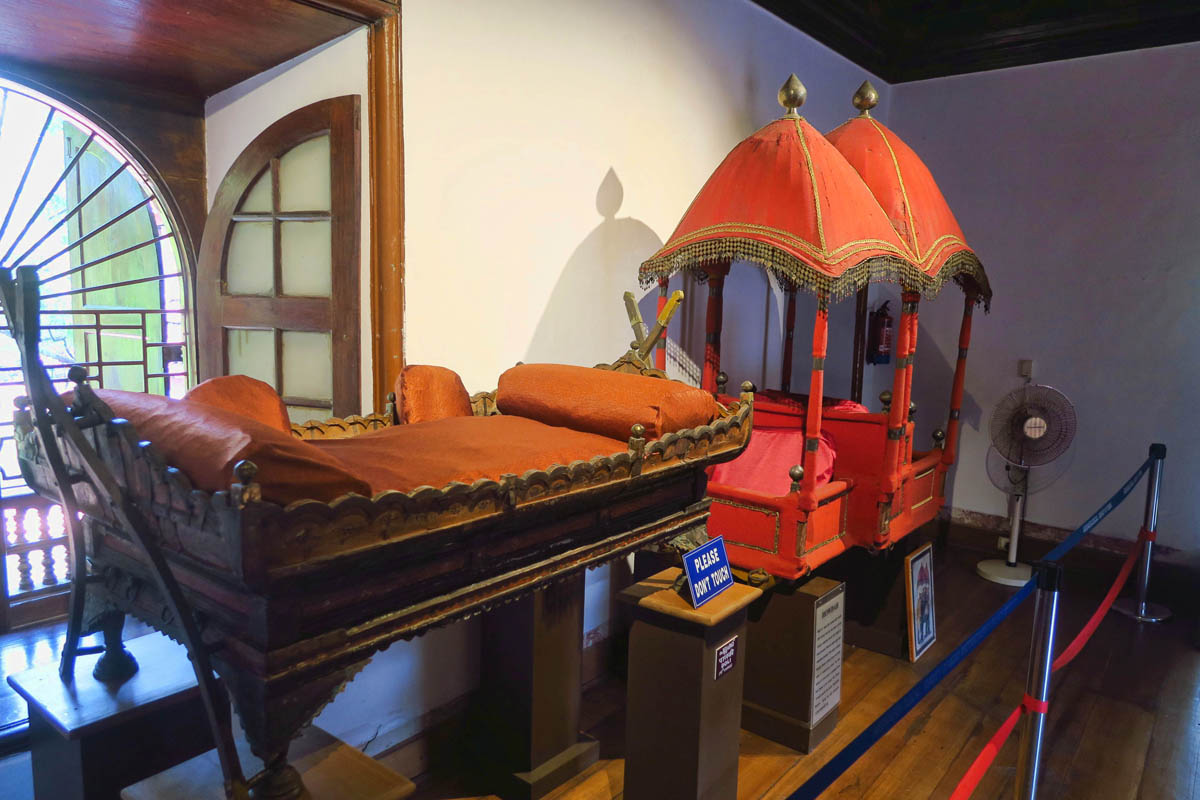
Inside Mattancherry Palace Museum, one of the oldest of the Portuguese structures built in the oriental style. The palace was built around 1555 A.D. Later in 1665 A.D. it became the Dutch Palace. These palanquins inside the museum were used for carrying royalty on the shoulders of 6-8 porters.
India is like being in a tiny kitchen in back of a curry restaurant that shudders at the mere mention of a health inspector. It’s hot. It’s steamy. It’s crowded and it’s noisy. Everything tastes and smells of the overpowering aroma of the fragrant spice blend, masala, a sinus-awakening mixture of ground cardamom, cinnamon, bay leaves, nutmeg, cloves, chilies and peppercorns. There is no sleepwalking through one’s shift in the Curry Cafe. It’s on-duty 24/7. From men who can’t conceive of the concept of “personal space” invading your waking hours, to malaria infested mosquitoes threatening any hope of a peaceful sleep, there is no escaping it. So why on earth would I want to spend two weeks there, let alone two months?
But the very reasons to hate India are the same reasons to love it. It’s INTENSE! I have always had a distaste for mediocrity, and nothing about India is mediocre. Due to its immense size, India is not only a country, but also classified as a “subcontinent.” From north to south, it varies as much as NY-style Cheesecake to South Carolina Cheese Grits. While my 2002 trip was spent primarily in northern India, I had yet to set foot south of Mumbai. So I began my southern tour with the city known as the “Queen of the Arabian Sea,” Cochin, later changed to Kochi. (Almost every city in India has two names, one based on the original spelling, and a revised version adapted during the times of British occupation. Many of the cities have now returned to their original spelling, such as Bombay to Mumbai, Calcutta to Kolkata, Mysore to Mysuru, etc.)

One of the many Hindu temples around Fort Kochi. This one can only be reached by small boat.

Jeevamatha Church, also known as Church of Our Lady of Life. These gigantic places of worship in stark contrast to the huts most people call home is never lost on me.
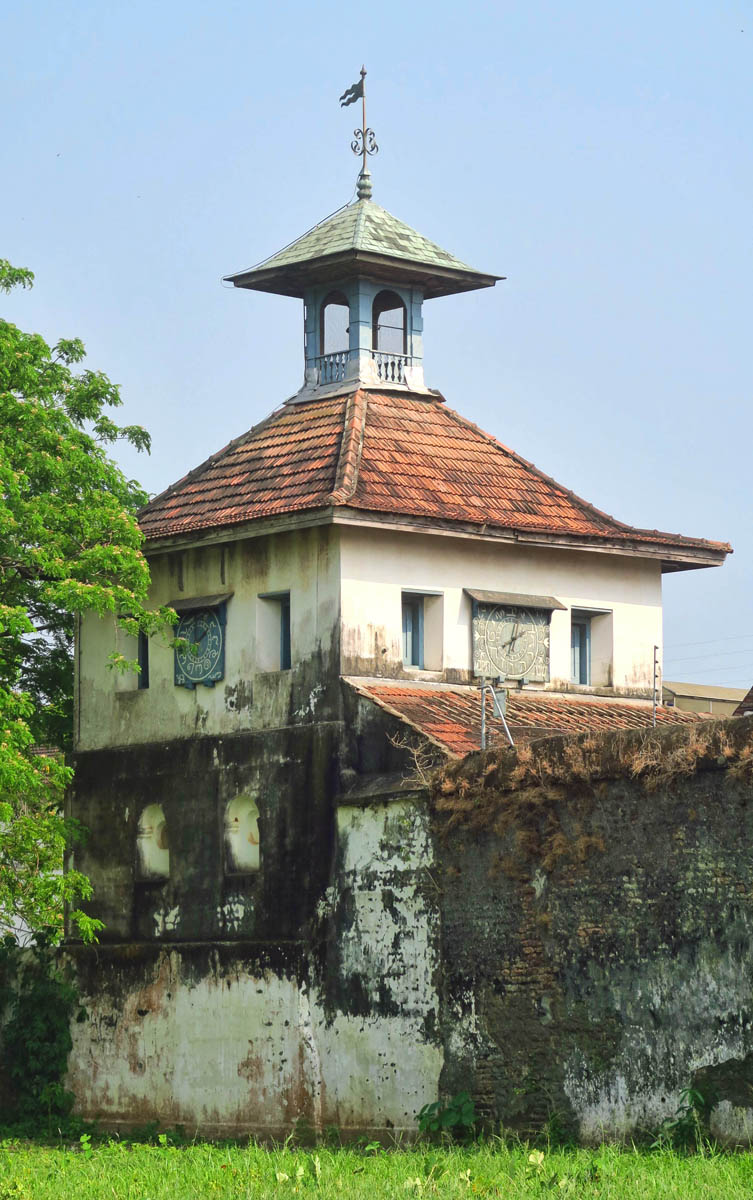
The Paradesi Synagogue built in 1580 is the oldest active synagogue in the Commonwealth of Nations. Its clock tower was added in the 18th century. The synagogue is located in the quarter of Old Cochin known as Jew Town, on Jew Street.

The Jewish Cemetery. The Paradesi Jews are the oldest group of Jews in India, with roots that are claimed to date back to the time of King Solomon. Only three remain in Kochi.

Nighttime religious ceremony outside of St. Anthony’s Shrine.
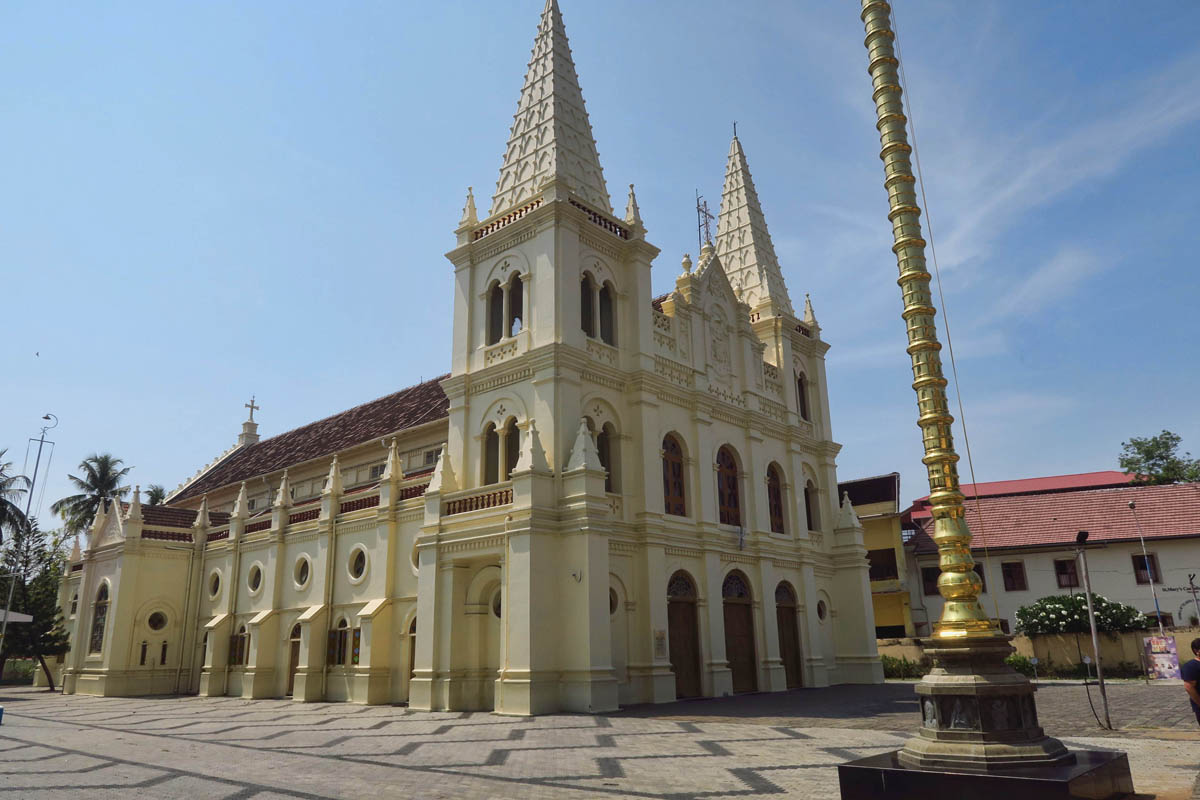
Santa Cruz Cathedral Basilica, Fort Kochi’s Roman Catholic cathedral consecrated in 1905. Atypical for India, nearly one-fifth of the Kerala population is Christian. (Five years with this camera, and I still chop off the top of the steeple!)
As the largest city in the state of Kerala, Kochi is a thriving port with bumper to bumper smog-belching traffic, crowded sidewalks with people spilling out into the streets, and towering skyscrapers lining the shoreline. But just across the bridge is the small hamlet of Fort Kochi, which feels like a village that has been locked in time. It’s isolated from the polluted, overcrowded “progress” of the main city by a stretch of waterway that can be crossed by a 15 minute tuk-tuk (aka “auto rickshaw”) or ferry ride.
As a hub of trade dating back to the Spice Routes, the Maritime Silk Roads linking east to west brought European influence to Fort Kochi. It was the first of the European colonies in colonial India, beginning with the occupation by the Portuguese in 1503. In fact, Portuguese Explorer Vasco De Gama was the first European known to reach India. Vasco de Gama made three voyages to India, his first being in 1498. He died in Fort Kochi of malaria, and was first buried at St. Francis Church. His remains were later returned to Portugal in 1539. He is now entombed in Jerónimos Monastery in Belem, Portugal where I visited last summer.
Following Portuguese rule, Kochi was captured by the Dutch in 1683 who ruled until 1795 when the British took control, maintaining it until 1947 when India declared independence. But long prior to colonial rule, Kochi was influenced by China as immigrants established a fishing and trade routes as far back as the 14th Century. Even the town’s name, “Cochin” means “like China.” The Chinese fishermen brought with them the unique mechanical fishing nets now considered to be the most famous landmark of Fort Kochi.
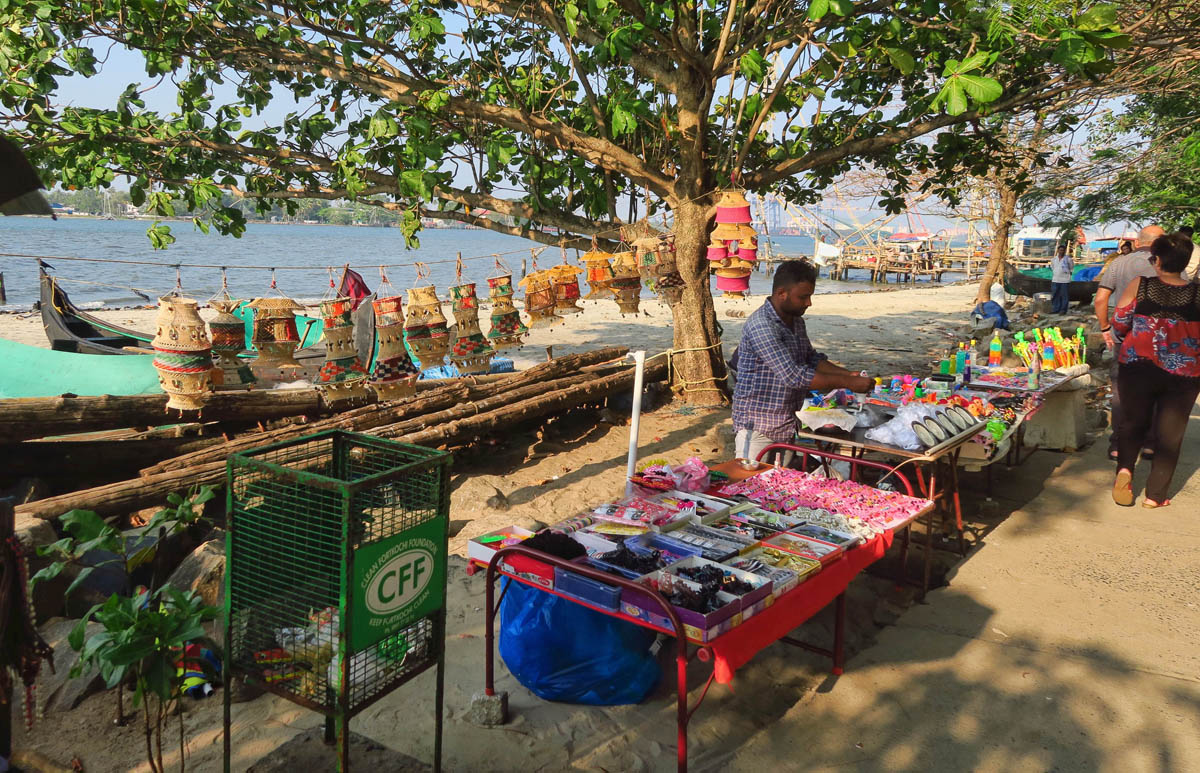
The guesthouse where I am staying is within close walking distance of the waterfront.
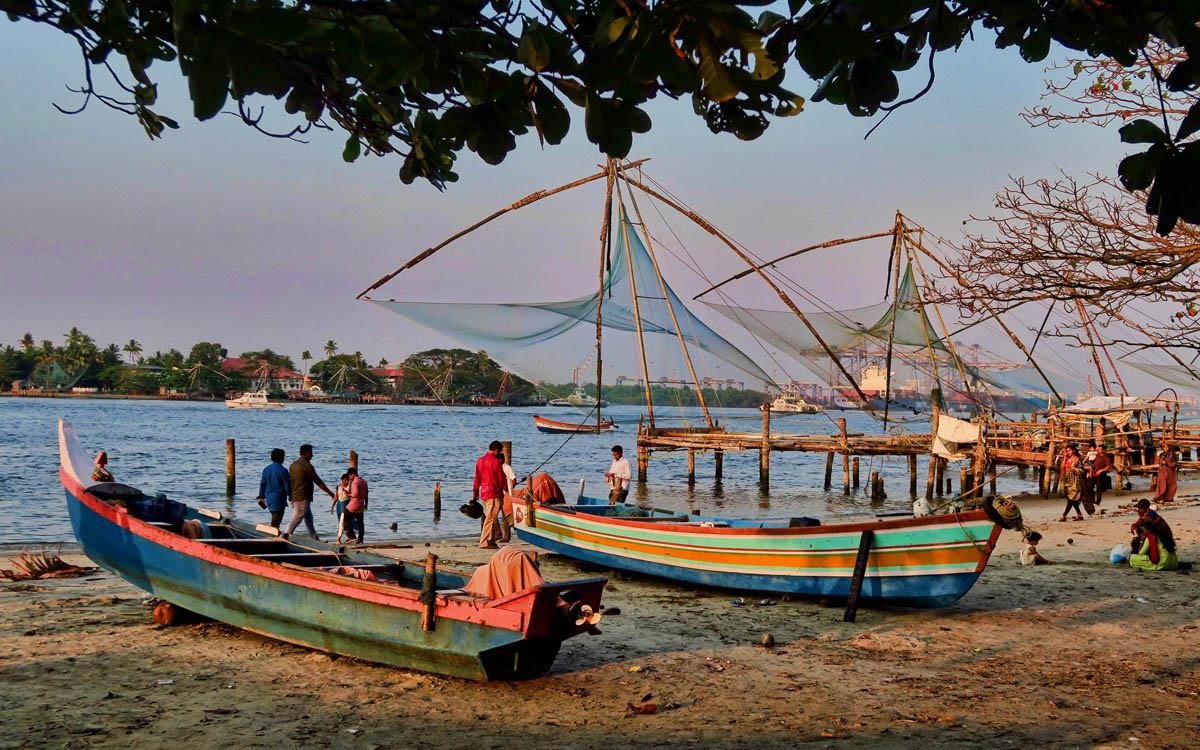
I love walking down at sunset and watching the activity.

Lots of fishermen along shore. More fishermen than there are fish.
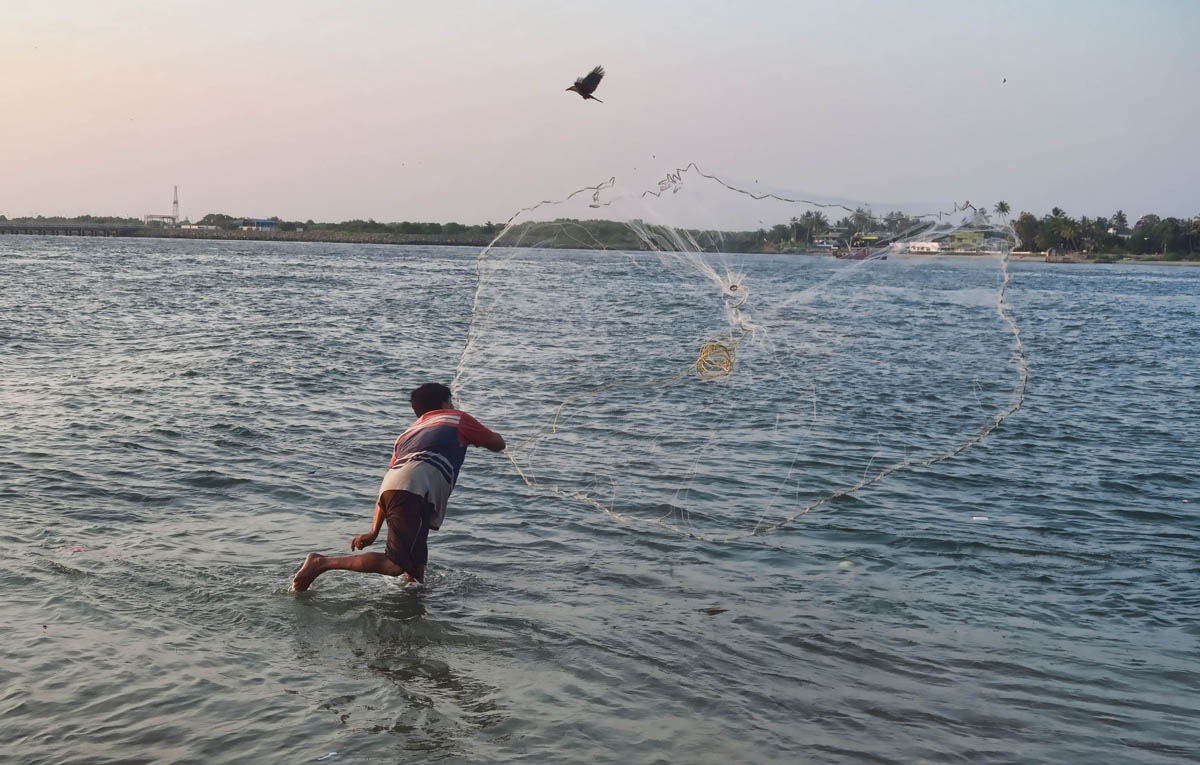
Casting his net, though I never saw anything come back.

But these are the main draw in Fort Kochi, the Chinese fishing nets, also known as stationary lift nets.
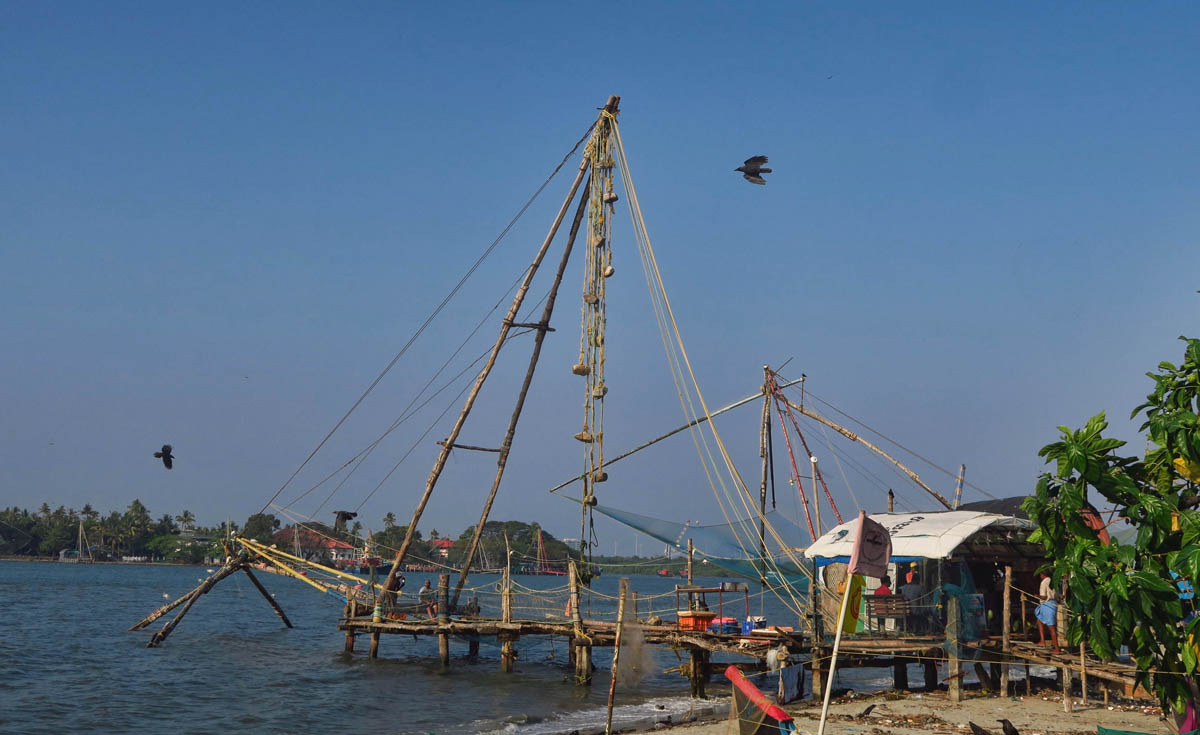
These horizontal nets reach 60 feet across and 30 feet high. Large stones suspended with ropes of different lengths act as counterweights, allowing the nets to be slowly lowered and raised. (Note net is submerged here. When net is raised, rocks will lower onto the deck.)
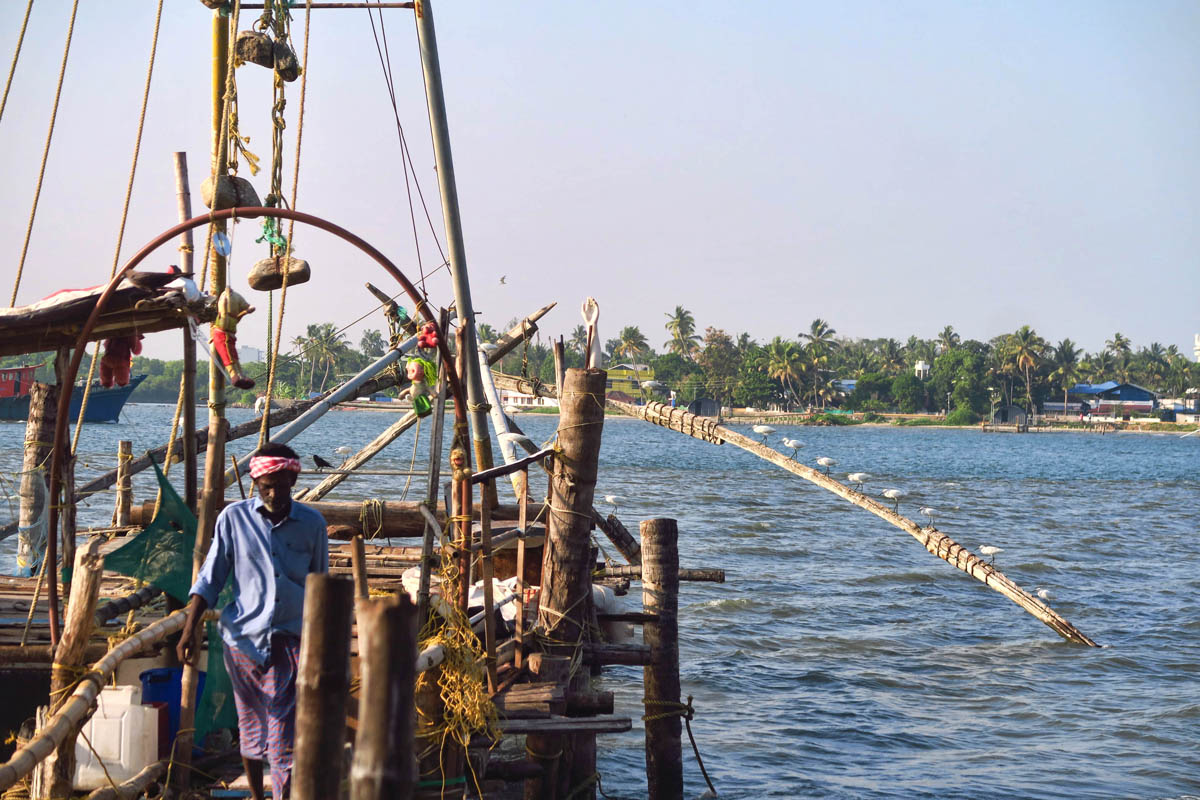
The system is balanced so that the weight of a man walking along the main beam is sufficient to cause the net to descend into the sea.

While the nets exist today mostly for tourism, it is possible to purchase some small fish to be cooked on nearby grills.
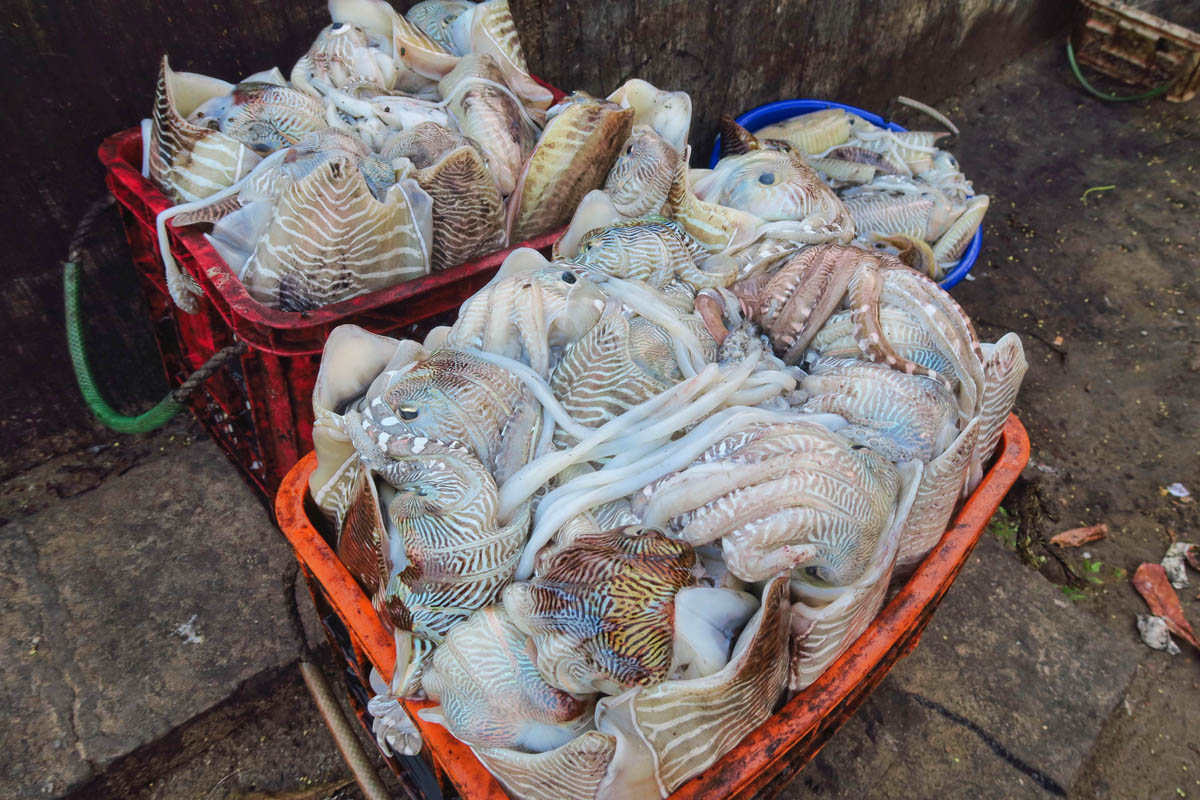
The area serves as an outdoor fish market. Here are giant cuttlefish (squid) and octopus for sale.
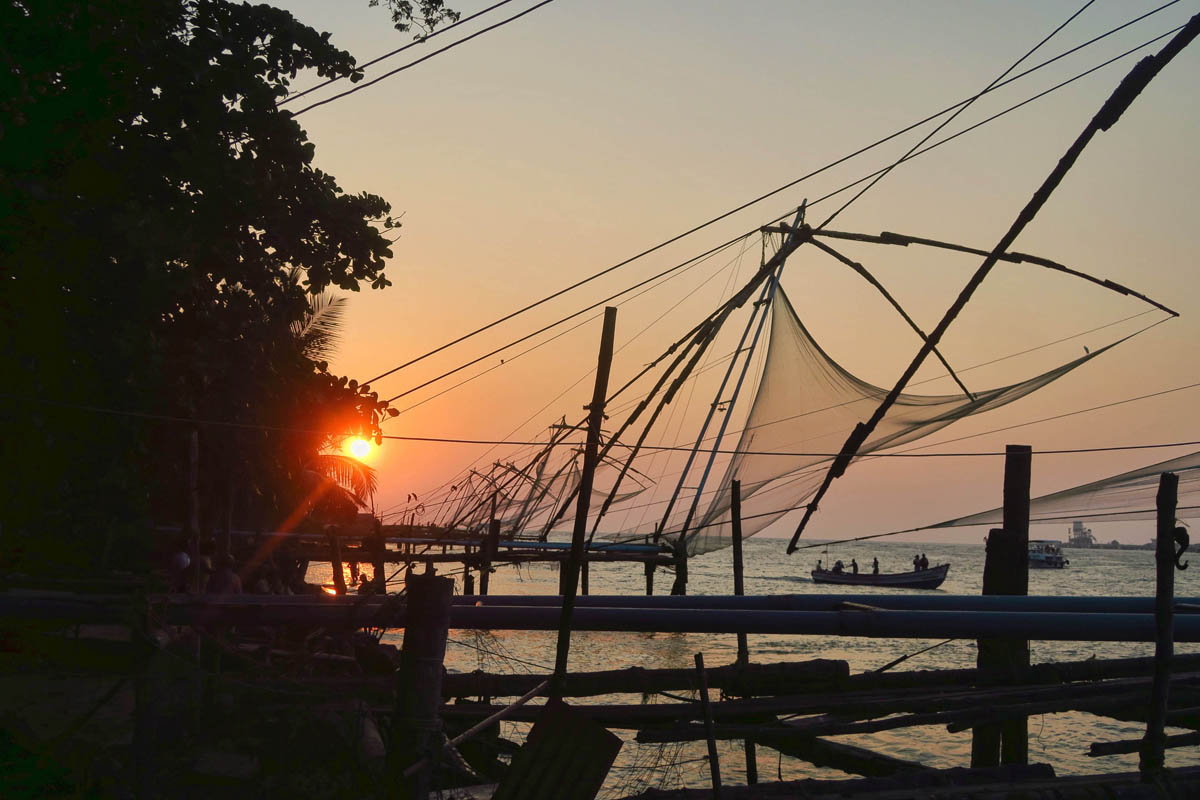
Going down to the waters edge to watch the nets at sunset was one of my favorite pastimes in Fort Kochi.
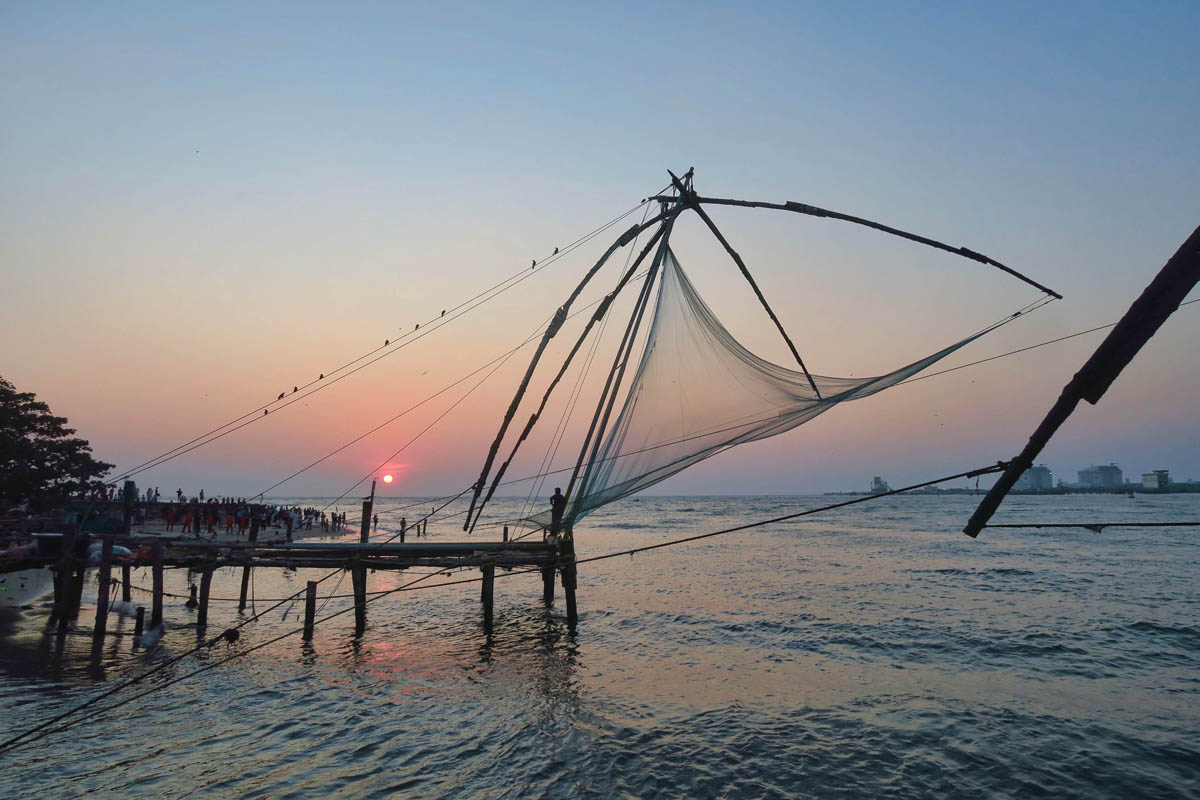
Can’t decide which sunset photo I like best, so I am including them both.
Fort Kochi is known for having an abundance of home stays and guesthouses, so I booked a week at the Green Wood Bethlehem Guesthouse. It was in a great location within walking distance of many attractions, but more so because the rave reviews on booking.com about the helpful owners. The Green Wood Bethlehem Guesthouse lived up to its reputation, as the two owners, Sheeba and her husband Ashley sat me down in their living-room in front of a large map, and spent an hour offering their tried and true recommendations, from walking tours to the best places to try south Indian cuisine.
I have talked before about why I find it preferable to stay in cheaper, backpacker-style accommodations as opposed to a little more upscale properties. While the rooms are not as accommodating, these cheaper style guesthouses typically come with some sort of community room where fellow travelers congregate. And when one is doing long term travel, the information to be gleaned from fellow travelers is invaluable.
But even more helpful were the conversations I had on the rooftop of the guesthouse where complimentary breakfast was served. I took to bringing a notepad and pen to breakfast each morning, as sitting at the communal tables with fellow travelers proved to be even more bountiful than the breakfast buffet. Throughout informative conversations, I washed down “idli” (rice cakes) with numerous cups of weak tea while making my list and plotting my course to explore the southern coastal state of Kerala.

Ferries link Fort Kochi with several surrounding islands, as well as the main city.
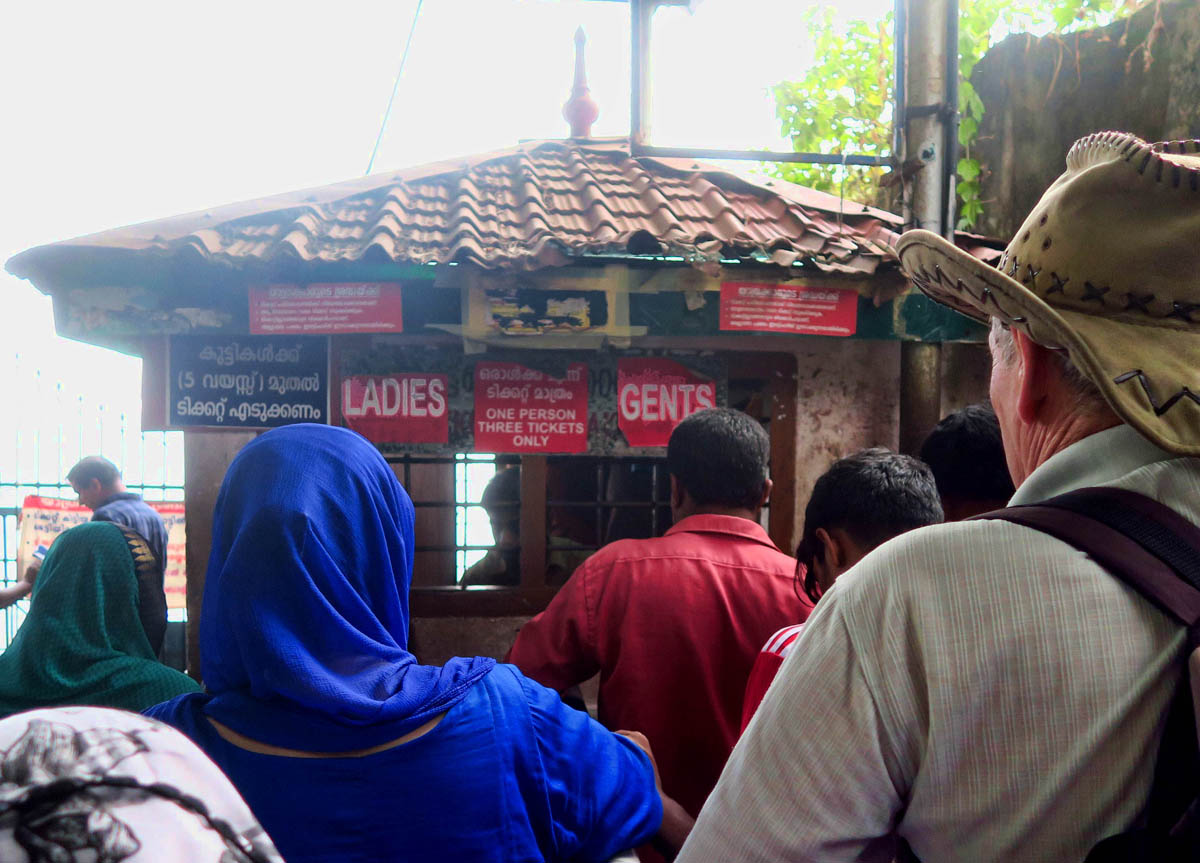
I took the ferry over to the port city one day. Most lines or queues and waiting areas in India are segregated into “Ladies” and “Gents.”

My old Android phone broke while in Ethiopia, so I went in to town to shop for a new one. This is one small corner of a huge mall dedicated only to sales of mobile phones and accessories. It was hot as hell in here, and everyone was shouting. Most intimidating shopping experience ever!

I am always running behind on the blog, so I frequently need to turn to Google to refresh my memory. While working on this post, every single search returned this banner “Temporarily Closed.” I really shudder to think about how hard life must be now for the millions of poverty-stricken in India. It makes my heart hurt.

My exact thoughts too as I read your post and admired your photos of people — how different their lives must be now!! Can you imagine the folks there trying to live in a virus-free bubble of their own? Interesting too about the Chinese fishing technique and their ways of life, washing, baking, gender-based lines, etc. Always a joy to read about your travels Suzanne!
Not a place I have any desire to go, but love seeing it through your eyes. Oh and welcome (a half year late) to medicare…..I thought we were the same age but nope, you’re younger 😉
That photo of the outside vendors by the waterfront is a wallhanger! Such beautiful colors; looks like a painting!
Hi Suzanne…I especially enjoyed the photo of the man ironing the shirt. For a minute or two I imagined how it probably had become almost meditative to him. Simple work, although not easy. It was so sweet to get this post and be reminded that there is a wide world outside my door…something that seems even farther away lately. And it was also a reminder of how differently this is impacting every human. My heart also aches for those who are poverty stricken.
Agree the iron was unique, never saw one like that one at antique stores in the USA. He was ironing a simple plaid shirt, probably an “every-day” shirt. I tossed my iron about 35 years ago. It still amazes me that being “neat as a pin” is important in some cultures.
No, no, no, not even if the trip was free. I do find it interesting to travel there vicariously through you however!
I would go solely to photograph those nets! Your photographs, as always are great!
Your planning for trips is very prescient! From my own recent experience you may think you know whats coming, but you don’t!
” Dont know what you’ve got til its Gone!” Big Yellow Taxi Joni Mitchell
What an outstanding post, Suzanne! So glad you went so you could share with those of us that are chicken to visit this very different country. I can just imagine all the powerful spice smells. Your photos are spectacular. It really helps me join you. I find myself smiling and sticking up nose at various shots…haha! The cuddle fish and octopus made me quiver. Love, love the Trump cartoon!!
Love your photography and your exceptional narration makes me feel like I am there.
Really enjoyed your photos but this is as close to India as I want to get 🙂
India is a conundrum and I appreciate your views of it. I am adventurous, but it doesn’t intrigue me as they seem to be captured by their culture and history while we value neither here in the nation of independence. I dinna ken WTF.